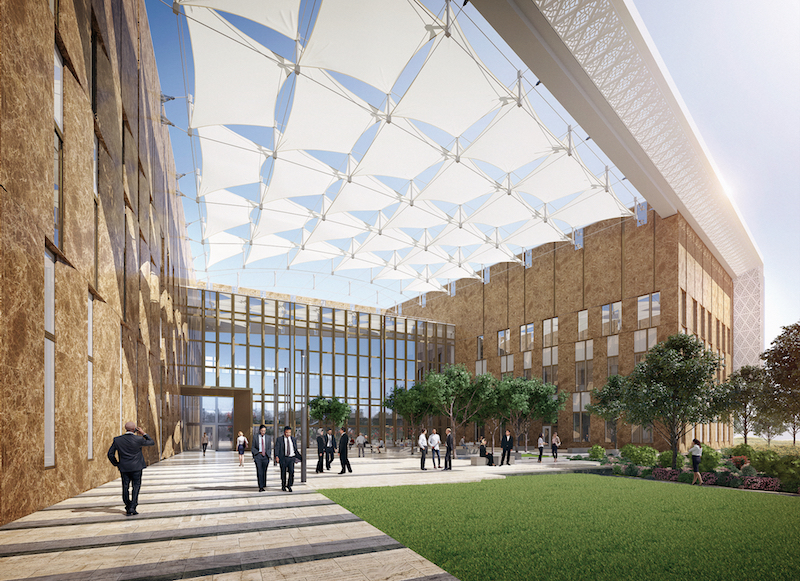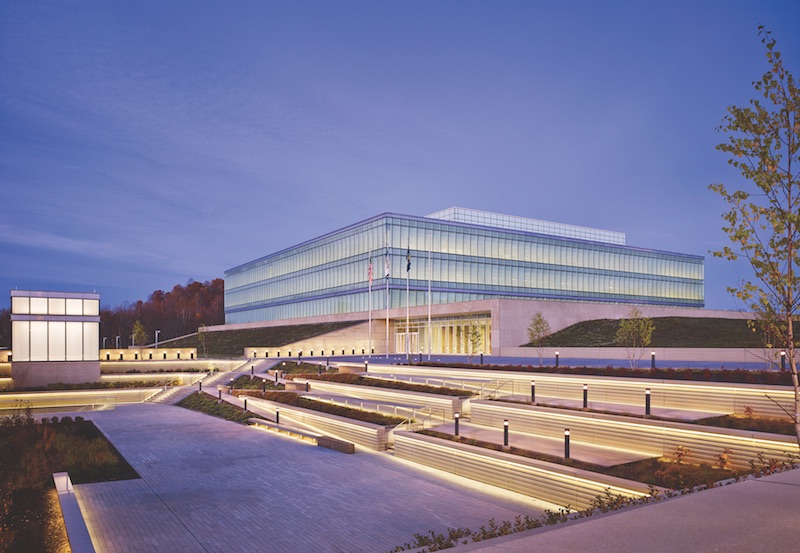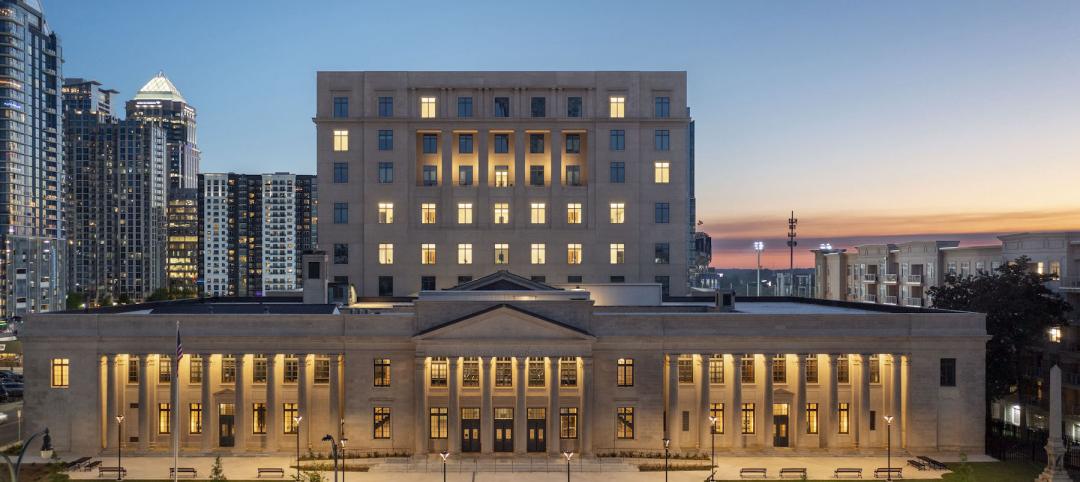The city of Chattanooga, Tenn., has been trying to get a new federal courthouse built for two decades. Its 84-year-old courthouse has been on the General Services Administration’s replacement list since 1999. But a new courthouse, which would cost around $157 million, once again fell just short of making the Federal Judiciary Courthouse Project funding priorities list for 2018.
So it goes for construction projects that are at the mercy of the political and budgetary vagaries of local, state, and federal governments.
Even the news that the Trump Administration’s 2018 budget calls for $200 billion in direct federal infrastructure spending over 10 years has AEC sources wondering whether that budget has any chance of passing, and how much of that money would end up financing nonresidential building and renovation.
Some firms are hopeful. “There is a lot of change occurring in all levels of government, which will create project opportunities,” says Karl Stumpf, AIA, LEED AP BD+C, Government Sector Leader with EYP.
Other firms, not so much. “Our federal healthcare clients know they are unlikely to see the level of capital investment to fulfill their current needs,” says Bill Kline, AIA, EDAC, LEED AP, who leads SmithGroupJJR’s Federal Programs–Healthcare group in Washington, D.C.
He notes that the Department of Veterans Affairs has identified 4,200 capital projects totaling more than $41 billion and 89 future projects totaling $10 billion, but is currently short $15 billion for capital improvements.
Seeking alternative funding sources
Public nonresidential construction spending was down in Q1/2017, according to Census Bureau estimates. But the value of construction put in place in March was still a seasonally adjusted $278 billion, evidence that governments are more selectively building, replacing, and improving
their inventories.
EYP’s Stumpf says all levels of government are still interested in investing in office projects that result in better space utilization and lower operating costs.
In May, the city of Gainesville, Fla., broke ground on a new 24,000-sf fire station, designed by Bentley Architects + Engineers. Gilbane Building Co. is serving as the CM at risk on this project, which comes on the heels of another fire station, administration, and headquarters facility that Gilbane recently completed for the city of Fort Myers, Fla.
But the inescapable fact is that local, county, and state governments are strapped for cash, or limited by balanced-budget mandates, to where “we’re not seeing public building projects, such as police and fire departments, municipal office buildings, courthouses, libraries, and community centers advancing quickly enough to meet community needs,” says Joseph Ruocco, AIA, Associate Director and Senior Project Manager with Skidmore, Owings & Merrill.
 The U.S. Consulate in Erbil, in Iraq’s Kurdistan region, will be the largest such facility in the world. Designer EYP is seeking to create a community whose features are familiar to Americans while also connecting to local culture. Rendering EYP.
The U.S. Consulate in Erbil, in Iraq’s Kurdistan region, will be the largest such facility in the world. Designer EYP is seeking to create a community whose features are familiar to Americans while also connecting to local culture. Rendering EYP.
Agencies at all levels are seeking to uncover new ways to get projects moving. The GSA now selectively employs a “real estate transaction exchange” with potential developers, where the agency offers land and development rights to a developer that provides a building designed to the agency’s specifications on a separate parcel. The developer gets the existing building that is being replaced and the land it’s sitting on, which it can use for future development.
Ruocco also notes that local, county, and state governments are more receptive to the design-build-finance-operate-maintain public-private partnership model, applied over a time frame that can extend 40 years.
At the federal level, SOM is finding that government agencies—such as the State Department’s Overseas Building Operations, the GSA, the Army Corps of Engineers, and the Naval Facilities Engineering Command—have successfully secured project funding over the past few years.
SOM has worked with OBO on new designs for missions in China. Last year, GSA secured congressional approval of nearly $947 million for its Federal Courthouse Program. Funding has been approved for new courthouses in Harrisburg, Pa., Huntsville, Ala., and Fort Lauderdale, Fla., to start building next year.
In St. Louis, the National Geospatial-Intelligence Agency West, a $1.75 billion, 800,000-sf facility, is slated to start construction next year, with completion scheduled for late 2022. Ruocco says this is one of the largest-scale projects to be issued since the Department of Defense’s 2005 Base Realignment and Closure Commission program in 2005.
Also See: BD+C Giants 300 government rankings
Top 95 government architecture firms
Top 55 government engineering firms
Top 85 government construction fimrs
SmithGroupJJR has established a relationship with the Department of Defense’s National Intrepid Center of Excellence (NICoE), a research, diagnostic, and treatment center for soldiers with traumatic brain injuries and post-traumatic stress, whose main facility is the Walter Reed National Military Medical Center, Bethesda, Md.
Arnold Fisher, Chairman of the Intrepid Fallen Heroes Fund, which led the initial fundraising drive for NICoE, has commissioned SmithGroupJJR to design template satellite centers for nine military bases, whose construction will be financed by the Intrepid Fallen Heroes Fund and gifted to the government upon completion.
The firm will complete the sixth of nine satellites this fall, at the Joint Base Lewis McCord, Tacoma, Wash., and has the seventh under construction at Camp Pendleton, in San Diego.
A fraught supply-chain ruling
Governments’ real estate holdings are vast, and its need to renovate and replenish its building stock will always present opportunities to AEC firms. Ruocco notes that many 1970s-era urban renewal projects are approaching their 50-year shelf life. “It’s time for their modernization or replacement,” he says.
But projects are more complicated today than they were a few generations ago. One potential game changer, says Kline, could be the fallout from a recent Supreme Court decision, Kingdomware Technologies, Inc. v. United States, which regards the implementation of set-aside requirements for veteran-owned small businesses under Federal Supply Schedule contracts.
The Court ruled that if two qualified disabled veteran-owned firms are available, the VA must contract with them over any other firm. That ruling, says Kline, will, at the very least “change the strategy architects and engineers use when competing for VA work.”
SEE ALL 2017 GIANTS 300 RANKINGS
Related Stories
Laboratories | Aug 24, 2023
Net-zero carbon science center breaks ground in Canada
Designed by Diamond Schmitt, the new Atlantic Science Enterprise Centre (ASEC) will provide federal scientists and partners with state-of-the-art space and equipment to collaborate on research opportunities.
Government Buildings | Aug 23, 2023
White House wants to ‘aggressively’ get federal workers back to the office
The Biden administration wants to “aggressively” get federal workers back in the office by September or October. “We are returning to in-person work because it is critical to the well-being of our teams and will enable us to deliver better results for the American people,” according to an email by White House Chief of Staff Jeff Zients. The administration will not eliminate remote work entirely, though.
Giants 400 | Aug 22, 2023
Top 115 Architecture Engineering Firms for 2023
Stantec, HDR, Page, HOK, and Arcadis North America top the rankings of the nation's largest architecture engineering (AE) firms for nonresidential building and multifamily housing work, as reported in Building Design+Construction's 2023 Giants 400 Report.
Giants 400 | Aug 22, 2023
2023 Giants 400 Report: Ranking the nation's largest architecture, engineering, and construction firms
A record 552 AEC firms submitted data for BD+C's 2023 Giants 400 Report. The final report includes 137 rankings across 25 building sectors and specialty categories.
Giants 400 | Aug 22, 2023
Top 175 Architecture Firms for 2023
Gensler, HKS, Perkins&Will, Corgan, and Perkins Eastman top the rankings of the nation's largest architecture firms for nonresidential building and multifamily housing work, as reported in Building Design+Construction's 2023 Giants 400 Report.
Government Buildings | Aug 7, 2023
Nearly $1 billion earmarked for energy efficiency upgrades to federal buildings
The U.S. General Services Administration (GSA) recently announced plans to use $975 million in Inflation Reduction Act funding for energy efficiency and clean energy upgrades to federal buildings across the country. The investment will impact about 40 million sf, or about 20% of GSA’s federal buildings portfolio.
Government Buildings | Aug 2, 2023
A historic courthouse in Charlotte is updated and expanded by Robert A.M. Stern Architects
Robert A.M. Stern Architects’ design retains the original building’s look and presence.
Urban Planning | Jul 26, 2023
America’s first 100% electric city shows the potential of government-industry alignment
Ithaca has turned heads with the start of its latest venture: Fully decarbonize and electrify the city by 2030.
Government Buildings | Jul 13, 2023
The recently opened U.S. Embassy in Ankara reflects U.S. values while honoring Turkish architecture
The U.S. Department of State’s Bureau of Overseas Buildings Operations (OBO) has recently opened the U.S. Embassy in Ankara, Turkey. The design by Ennead Architects aims to balance transparency and openness with security, according to a press statement. The design also seeks both to honor Turkey’s architectural traditions and to meet OBO’s goals of sustainability, resiliency, and stewardship.
Green | Jun 26, 2023
Federal government will spend $30 million on novel green building technologies
The U.S. General Services Administration (GSA), and the U.S. Department of Energy (DOE) will invest $30 million from the Inflation Reduction Act to increase the sustainability of federal buildings by testing novel technologies. The vehicle for that effort, the Green Proving Ground (GPG) program, will invest in American-made technologies to help increase federal electric vehicle supply equipment, protect air quality, reduce climate pollution, and enhance building performance.

















